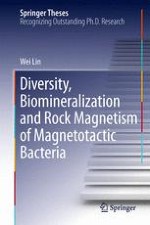Magnetotactic bacteria (MTB) synthesize intracellular nano-sized minerals of magnetite and/or greigite magnetosomes for magnetic orientation. They play important roles in global iron cycling and sedimentary magnetism, and have a broad range of potential applications in both biotechnological and biomedical fields. However, because the majority of MTB in nature remain unculturable, our understanding of these specific bacteria remains fairly limited. This thesis describes the development of a novel approach for effectively collecting, purifying and characterizing uncultivated magnetotactic bacteria. The diversity, genomic information and rock magnetic properties of various uncultivated MTB are investigated and characterized using a combination of biological and geophysical methods. The results will lead to a better understanding of the biogeography and biomineralization mechanisms of MTB in nature, and improve our knowledge of the contributions of MTB to biogeochemical cycles of elements and sedimentary magnetism.
Dr. Wei Lin works at the Institute of Geology and Geophysics, Chinese Academy of Sciences, China
